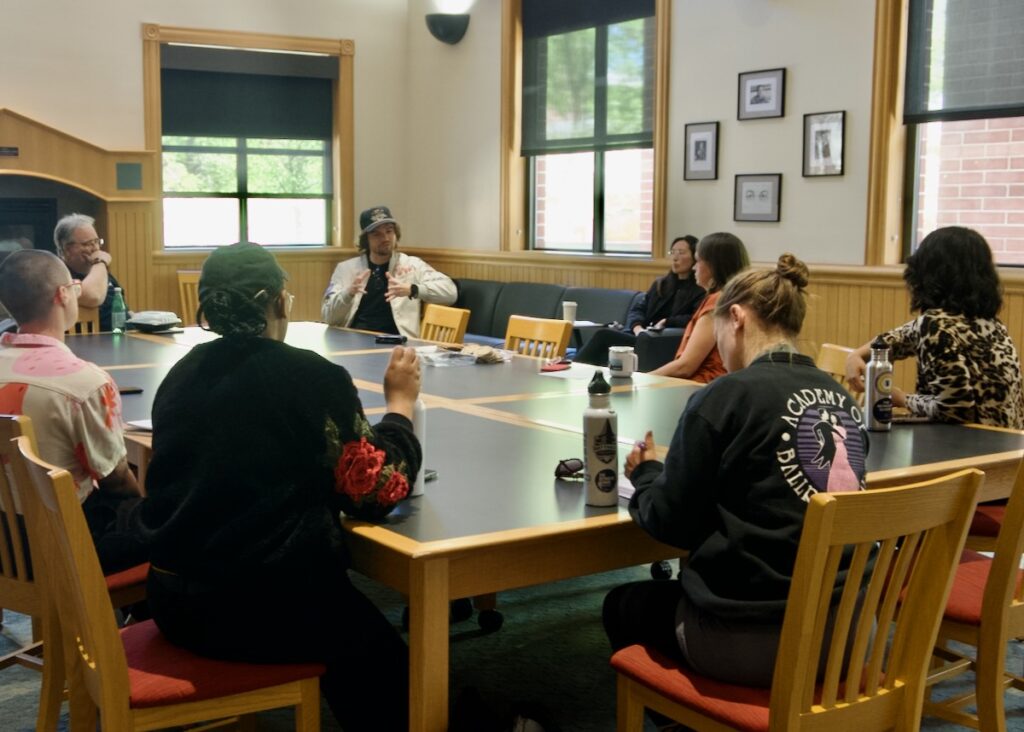The spacecraft, OSIRIS-REx, was silver and round, with solar panels that resembled the wings of Harry Potter’s golden snitch. Its mission was to travel to asteroid Bennu to collect samples and return to Earth. Late last spring, inside the UNR planetarium, an audience rode vicariously along as the NASA spacecraft successfully collected the needed samples. The experience was made possible during the Fleischmann Planetarium’s Sci-On! Film Festival, in which NASA filmmaker James Tralie visited Reno to premiere his new documentary, “OSIRIS-REx: To an Asteroid and Back.”
Tralie has an extensive background in both geosciences and film. A graduate of Princeton University, he majored in geosciences, where his studies ranged from mass extinction events to tidal research, computational modeling, and earthquake research. Throughout his academic journey, Tralie balanced his scientific foundation with a passion for creative expression that led him to internships with the Discovery Channel in France and a stint at an LA ad agency. Five years ago, Tralie was hired as a producer and animator at NASA.
During his visit to Reno, Tralie met with the Hitchcock Project and a group of students from the Reynolds School of Journalism to discuss his career in science communication and answer their questions. Here are some insights shared during that conversation.
Hitchcock Project: Can you tell us about a typical day on the job as a science communicator for NASA?
Tralie: I work in the Planetary Science Division for NASA, which includes missions to planets in our solar system and beyond. I get to cover those on a day-to-day basis. It is a lot of working directly with scientists, so it helps to have a science background to be able to work as a translator. Half the battle is just trying to understand what you are trying to communicate and taking the extra step to really translate it into something that will resonate with readers, viewers, and with the public to get them inspired and understand why this is such important work. It is always fun to sit down with scientists and parse through much of the jargon as they are used to talking to the same five people who study a niche topic. So, you must get them to walk it back and explain it a little bit of a higher level.
HP: How do you come up with ideas for the topics you will cover?
Tralie: It is different for every project, and that makes it a unique challenge. A lot of stuff comes to me as just a primary source paper. Scientists will mention that they are going to be publishing some new results soon, and they will give me their primary source, which is often super technical. It is my job to then sit with them to make sure that the science is being accurately communicated all throughout the process. So, a lot of times it is just storyboarding the ideas out, drawing pictures, starting to do some basic animatics, and so on.
HP: How has your background in science helped you communicate with scientists and create your art?
Tralie: I think I’m one of the only people on my media team who has a background in science. Other people came directly from schools of journalism and media programs. It certainly helps to have that science background because I feel like I understand a lot of the technical jargon. But you do not necessarily have to have that background, as you also kind of learn on the job as you read these papers and get more familiar with the science, to the point where you feel free to ask questions. The scientists are phenomenal and a lot of them are media trained too, so they’re really used explaining things on TV programs or walking you through their research and sitting down with you or taking you into the lab. You can really learn a lot from them; it is almost like a classroom setting. So, you do not necessarily have to have that experience. It certainly helps, but it’s not necessary.
HP: How do you find the balance between accuracy and trying to communicate science to general audiences?
Tralie: We always try to stay as truthful as possible to science, to keep it to the source material. But I feel like we have, for some of my pieces, been able to stretch NASA a little bit away from some of the more technical explainer video-types, to do more creative things.
I am currently working on a series inspired by the retro-futuristic style of The Jetsons. This project is tied to our Lucy Mission, which is exploring a group of asteroids known as the Trojans. Since it’s a 12-year-long mission, we’re targeting the next generation of scientists—those who are currently in middle school or high school—who might one day work on this mission. I pitched the idea to the mission team, suggesting that we market it to a younger audience using a character similar to R2-D2. While the spacecraft isn’t a person, we can personify its instruments and camera equipment to make it more lifelike and engaging.
In the cartoon, we gave the spacecraft some animated, cartoonish movements, although these go beyond what it does. Despite this creative liberty, we ensure the core message remains focused on the exploration and science of the mission. We discuss the targets, the imaging done by its cameras, and how those cameras work. This approach allows us to present the scientific aspects in a fun way and reach a wider audience. So, we aim to balance creativity with scientific accuracy, ensuring we stay as truthful as possible while making the content engaging.

HP: How have the scientists’ responses been? Have you faced challenges when trying to communicate your ideas to them?
Tralie: Early on, it was quite challenging because I had to prove myself. I did not have much of a portfolio to highlight the kind of content I could create. When pitching ideas, there was often confusion or skepticism about what I was proposing. However, now that I have a track record, scientists have started reaching out to me because they appreciate my style of work. Recently, I have been working on a TV series featuring longer-form pieces. These episodes delve deeper into the lives of scientists and engineers, following them behind the scenes on a day-to-day basis. We capture their research process and reactions candidly, like a reality TV show.
Sometimes there’s pushback, so it is crucial to present a clear idea. I storyboard my concepts and, if possible, use mood boards or rough animatics to visually communicate what I am aiming for. It is not always easy to articulate an idea until you can show a rough animation.
Being confident and clear in your vision is essential. You also need to reassure the scientists that they will have input to ensure the accuracy of the science being portrayed. While there are occasional challenges, I feel that I have mostly been able to produce the content I envision.
HP: Do you use resources such as green screens and other technologies when showing outer space images, or is it actual footage?
Tralie: We try to use actual as much as possible. A lot of the telescope footage that comes back, even ground-based telescope technology captures some amazing imagery from our spacecraft. We try to use that as much as possible. We do have a green screen, but we do not use it that much anymore because the imagery that has come back is just so incredible.
HP: What kind of control do you have over the footage that is collected?
Tralie: I must use what is there for us. So, if there is a spacecraft capturing imagery in a certain orientation or capturing a certain event, we will use what they are filming for. We will often have a couple of different angles because of a couple of different cameras on board. So, we have to work around what they have for us, which is sometimes a challenge. If you want a certain angle, they cannot always go back and film it again.
HP: Can you describe the process behind creating your animations?
Tralie: Our animation workflow is quite typical, starting with storyboards where we sketch out the images and outline the basic story. Often, scientists approach me with their work, and I spend a few days understanding what they want to present. For example, one of my first animations was about a phenomenon called sporadic E, which involves radio interference caused by high concentrations of plasma in the ionosphere of both Earth and Mars. When the scientist explained this to me, I envisioned a staticky, comic book style similar to the Spider-Verse. I pitched this idea to them, and they were very receptive.
After that, I sketched out the storyboard, mapped out the story using their real data, and scripted the narration to guide the direction. Once they approved this, we moved to the pre-visualization stage, where we started animating using our software. After getting their approval on the previz, we proceed to full CG animation, finishing with editing and compositing to get it ready for release.
We do most of the work in-house, although we sometimes hire freelancers. We have a dedicated animation team, and I also do a lot of my own animations. It’s a very hands-on process.
HP: Have you ever dreamed of being and astronaut and going to space?
Tralie: Absolutely! In fact, we just closed our applications for a new batch of astronauts a couple of weeks ago. We are highly motivated as we prepare for the next big chapter with NASA’s Artemis program, which focuses on returning to the Moon and then going beyond. It is an exciting time; a lot of sci-fi concepts are becoming real. On the first round of this mission, we are sending astronauts on the Artemis II mission, which will include a tour around the Moon next February. I have always wanted to be an astronaut, and I am just missing a master’s degree. I am considering going back to school to get that degree, and then I would love to pitch myself as a filmmaker for space. Capturing these moments in IMAX and bringing a cool visual approach to how we film in space would be incredible.
I often talk about space but have never been there. I keep pitching the idea that to really understand and communicate space science, I need to experience it firsthand. There have been civilians in space for various research and outreach projects, so there is room for people outside the core astronaut group to participate. So, who knows? Fingers crossed!

Vanesa de la Cruz Pavas, M.A., is a reporter and science communication specialist for the Hitchcock Project. She is a graduate of the Reynolds School of Journalism’s class of 2023.






